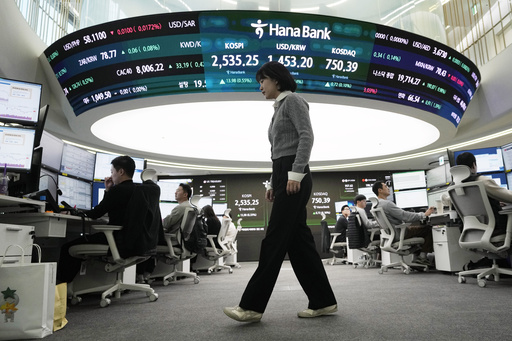
Wall Street is poised to open lower on Tuesday as new tariffs from the White House have been announced, igniting further market concerns. Investors are also bracing for a wave of corporate earnings reports and the much-anticipated testimony from Federal Reserve Chairman Jerome Powell in front of Congress, which will occur later in the day.
S&P 500 futures have dropped by 0.5%, while Dow Jones Industrial Average futures are down 0.3%. Similarly, Nasdaq futures have also reflected a decline of 0.5%.
In contrast, Coca-Cola shares saw a 3.4% increase after the beverage company exceeded expectations for fourth-quarter sales, driven by robust demand in the U.S., China, and other markets. Moreover, Coca-Cola’s earnings surpassed Wall Street’s profit forecasts, contributing to investor optimism.
DuPont shares surged by 5.6% as the chemical manufacturer reported strong sales and profit figures that eclipsed analyst predictions. The company attributed its performance to strong demand in its electronics segment, which is set to be spun off later this year.
Markets in Asia experienced a downturn on Tuesday following President Donald Trump’s announcement of 25% tariffs on all U.S. imports of steel and aluminum. The Hang Seng index in Hong Kong fell by 1.06%, landing at 21,294.86, while the Shanghai Composite saw a small decrease of 0.12% to 3,318.06. Japanese markets were shut down for a national holiday. However, the S&P/ASX 200 in Australia remained relatively stable, and South Korea’s KOSPI rose by 0.71% to close at 2,539.05.
European markets opened on a steady note, with France’s CAC 40 up by 0.2% and Germany’s DAX gaining 0.3%. Conversely, Britain’s FTSE 100 remained largely unchanged.
Over the weekend, Trump confirmed his plan to implement 25% tariffs on all steel and aluminum imports, with further import duties expected to be announced later this week. The uncertainty surrounding these tariffs has been a significant factor behind Wall Street’s recent fluctuations. Analysts suggest that the markets are likely to experience more volatility ahead. Gold prices, often seen as a safe haven during times of uncertainty, fell back to $2,909 per ounce after reaching a record high of $2,930 on Monday.
However, Trump has previously shown a willingness to retract threats, similar to the 25% tariffs he had initially proposed for Canada and Mexico, leading some to believe that these tariffs could be used as bargaining tools rather than forming the core of his economic strategy.
When it comes to Chinese trade relations, Trump has moved forward with 10% tariffs on Chinese imports, prompting China to retaliate with tariffs on U.S. coal, liquefied natural gas products, crude oil, agricultural machinery, and large-engine vehicles.
Vishnu Varathan, head of macro research at Mizuho, explained that Beijing seems to be opting for a restrained approach by targeting a narrow range of U.S. goods, which is viewed as a strategy to avoid escalating tensions further. Nonetheless, he noted that U.S.-China trade relations are likely to intensify over time, even if a negotiated agreement remains the ultimate goal regarding Trump’s tariffs.
In the bond market, the yield on the 10-year Treasury rose slightly to 4.53%, up from 4.50%, while the yield on the two-year Treasury remained unchanged at 4.29%. This two-year yield is particularly sensitive to expectations about the Federal Reserve’s short-term interest rate decisions. The Fed had reduced its principal interest rate multiple times towards the end of the last year, but traders have begun to recalibrate their expectations for further rate cuts in 2025, largely due to concerns over rising inflation resulting from tariffs. Although lower rates can stimulate the economy and bolster investment prices, they also have the potential to exacerbate inflationary pressures.
Today’s spotlight will undoubtedly be on Fed Chair Powell as he gives his testimony before Congress, where it is anticipated that he may provide insights regarding the Fed’s future direction. In December, comments made by Fed officials led to a significant decline in market performance after it was indicated that only two rate reductions might occur this year.
In energy markets, benchmark U.S. crude climbed by $1.21 to reach $73.53 per barrel, while Brent crude, considered the global standard, rose by $1.33 to $77.20 per barrel.
In currency trading, the U.S. dollar increased to 152.35 against the Japanese yen, while the euro remained stable, trading at $1.0319.

